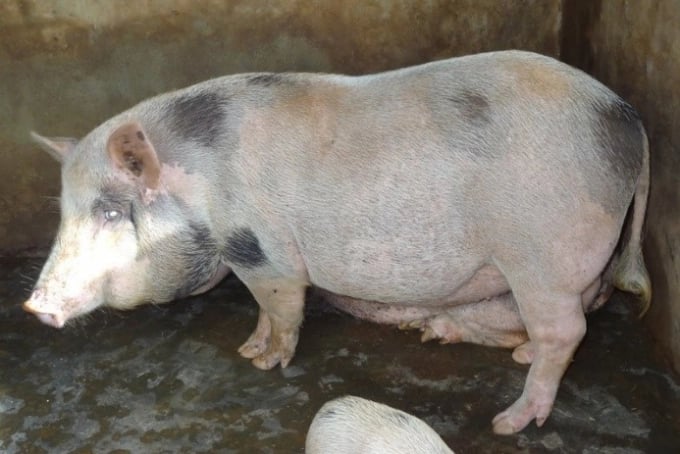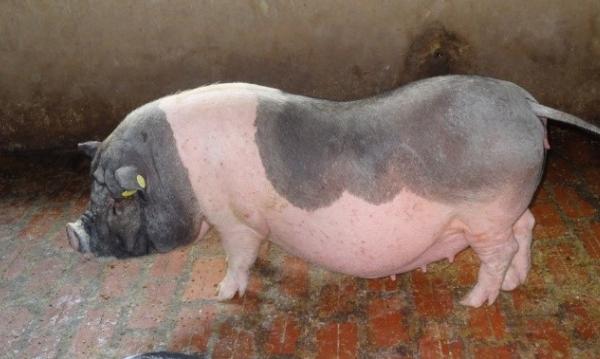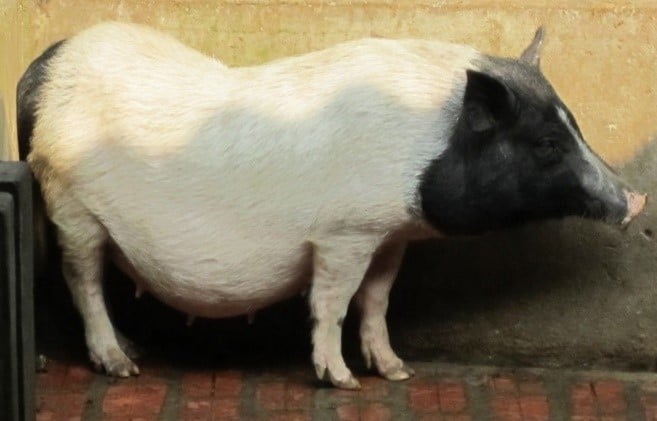May 25, 2025 | 05:12 GMT +7
May 25, 2025 | 05:12 GMT +7
Hotline: 0913.378.918
May 25, 2025 | 05:12 GMT +7
Hotline: 0913.378.918
Origin and distribution: Binh Thuan grass-fed pig is concentrated in Ham Thuan Bac and Tanh Linh, Binh Thuan province.
Appearance characteristics: Binh Thuan grass-fed pig has jet-black hair, firm body, bare forehead, long face, straight snout.
Prolificacy: First in heat at 8 months old, can be mated at 8.5 months and gives birth at 12.3 months old. Average litter size and number of weaners are 7.6 and 6.7 respectively. It weans at 70 days of age and weighs 6kg at this time.
Direction of use: Breed for specialty pork products.

Origin and distribution: In Chu Prong district, Gia Lai province.
Appearance characteristics: White hair with dark skin spots, unclear black hair spots around the eyes, the forehead or the body. The head is a bit small, the ears are upright, the face is slightly wrinkled, the back is straight, the belly is quite slim. This kind of pig has 10 to 12 breasts and big, strong and firm legs.
Prolificacy: In heat for the first time at 6 months of age and gives birth at 12 months of age. Average litter size and wean size are 7 and 6.5, respectively. Wean at 56 days. Newborn piglets weigh 0.43kg, weaners weigh 4 kg and 8 month old ones weigh 35kg.
Direction of use: Breed for specialty pork products.

Origin and distribution: Ha Lang and Bao Lam districts, Cao Bang province.
Appearance characteristics: Ha Lang pig has many physical features like those of Mong Cai pig: a white belly and a saddle strip over the shoulder, but they also have very characteristic physical features of their own: large body, short round snout, wrinkled and large face, big and short legs, sagging back but the belly does not touch the ground.
Prolificacy: Sow has from 10-12 breasts, average litter size is 8-10. Female pig can be mated at 210 to 236 days old, with the weight of 43 kg. The number of weaners/litter ranges from 7.43 to 9.11. The weight of piglet at 42 days old is 4.0 - 4.5kg; at 8 months old 42 - 46 kg.
Direction of use: Ha Lang pig breed is often used by local breeders as sow.

Origin and distribution: In the districts of Bac Me, Hoang Su Phi and Vi Xuyen, Ha Giang province.
Appearance characteristics: the hair is reddish, long and hard with silver luster. The body is short and lean, the ears are small and upright, the back is straight, some are slightly sagging. Small legs, stand on hoofed toes, reddish-brown or chestnut eyes, small face, long and pointed snout, long and small tail, compact belly, and fast and steady gait.
Prolificacy: Can be mated at 260 days of age, gives birth at 380 days of age. Average litter size and weaners is 7.4 and 6.5 respectively. Wean at 60 days and weigh 6kg at this time. A sow can give birth to 1.7 litters/year. The weight of an 8-month pig reaches 40 - 42kg. Can be sold when reaching 50kg; consume 4.3kg of animal feed for 1kg of weight gain.
Directions for use: Breed for pork products in areas with poor farming conditions or for and specialty pork products.

Origin and distribution: Appeared a long time ago in some highland districts along China-Vietnam border of Cao Bang province: Hoa An, Bao Lac, Bao Lam, Ha Lang and also popularly raised in that area.
Appearance Characteristics: white hair and skin with some black patches on the head and buttocks. There are black hazes between the black and white hair that is almost like Mong Cai pig but there is no white saddle that goes over the shoulder, only a white streaks running down the forehead to the muzzle.
Moderately large head, small and upright ears. The belly is slim, neat, not sagging like a Mong Cai pig. The legs are big, long and strong, and the back is relatively straight. Straight face, long muzzle. Huong pig has 8-12 breasts.

Prolificacy: gives birth at 13 months old. Average size of litter and weaners are 8 and 7 respectively, with a parity interval of 215 days. Newborn piglets weigh 0.4 kg, 60-day weaners weigh 5kg. 8 month old ones weigh 45 kg.
Direction of use: Crossbred sows with exotic males to serve households farming in Cao Bang as well as some neighboring provinces and used as specialty pork.
Author: Nguyen Huan. Translated by Meagan Phan. Edited by Duc Huy.

(VAN) The People's Committee of Tra Vinh province has approved an adjustment to the investment policy for the Green Hydrogen Plant project, increasing its area to approximately 52.76 hectares.
![Reducing emissions from rice fields: [2] Farmers’ commitment to the soil](https://t.ex-cdn.com/nongnghiepmoitruong.vn/608w/files/news/2025/05/05/dsc08881jpg-nongnghiep-140632.jpg)
(VAN) Clean rice cultivation model in Thuong Tan commune, Bac Tan Uyen district, is assisting local residents in achieving sustainable agriculture by substantially reducing costs, increasing productivity, and protecting the environment.

(VAN) At the conference to disseminate Resolution No. 68, AgriS introduced its digital agricultural ecosystem and reaffirmed its commitment to accompanying the Government in promoting private sector development and sustainable agriculture.

(VAN) 'Blue Ocean - Blue Foods' initiative is designed to restore marine ecosystems and establish sustainable livelihoods for local communities by cultivating a minimum of 1,000 hectares of cottonii seaweed in the first three years.
/2025/05/21/4642-3-112707_603.jpg)
(VAN) The V-SCOPE project has made direct contributions to three out of six pillars of the Comprehensive Strategic Partnership between Vietnam and Australia.

(VAN) Facing the threat of rabies spreading to the community, Gia Lai province urgently carries out measures to vaccinate dogs and cats on a large scale.

(VAN) Disease-free livestock farming not only protects livestock herds but also stabilizes production and livelihoods for many farmers in Tuyen Quang.